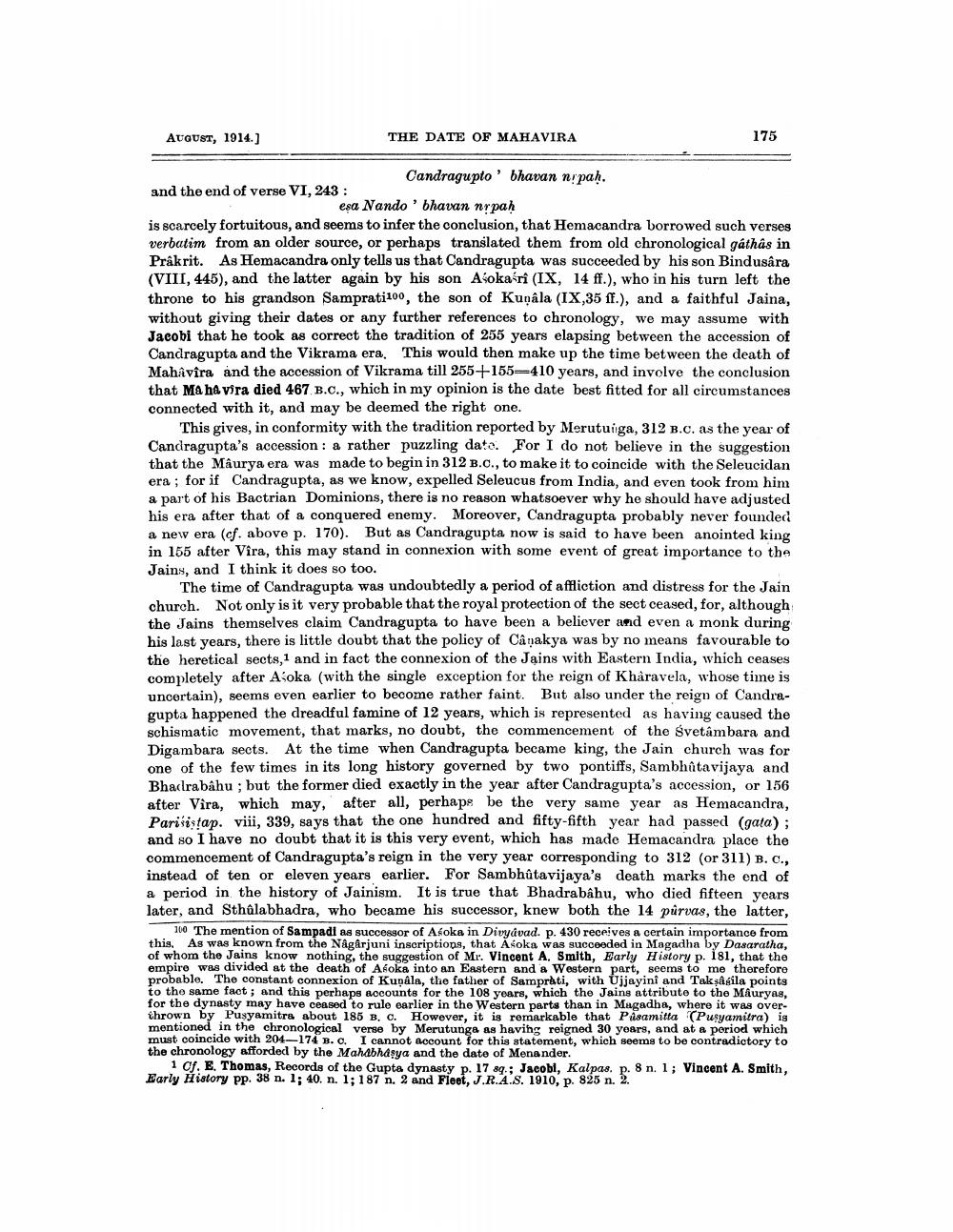________________
August, 1914.]
THE DATE OF MAHAVIRA
175
Candragupto' bhavan nipah. and the end of verse VI, 243 :
esa Nando' bhavan nrpah is scarcely fortuitous, and seems to infer the conclusion, that Hemacandra borrowed such verses verbatim from an older source, or perhaps translated them from old chronological gáthás in Prakrit. As Hemacandra only tells us that Candragupta was succeeded by his son Bindusara (VIII, 445), and the latter again by his son Alokasri (IX, 14 ff.), who in his turn left the throne to his grandson Samprati100, the son of Kuala (IX,35 ff.), and a faithful Jaina, without giving their dates or any further references to chronology, we may assume with Jacobi that he took as correct the tradition of 255 years elapsing between the accession of Candragupta and the Vikrama era. This would then make up the time between the death of Mahậvira and the accession of Vikrama till 255+155—410 years, and involve the conclusion that Ma ha vira died 467 B.C., which in my opinion is the date best fitted for all circumstances connected with it, and may be deemed the right one.
This gives, in conformity with the tradition reported by Merutunga, 312 B.C. as the year of Candragupta's accession : a rather puzzling date. For I do not believe in the suggestion that the Maurya era was made to begin in 312 B.C., to make it to coincide with the Seleucidan era ; for if Candragupta, as we know, expelled Seleucus from India, and even took from him a part of his Bactrian Dominions, there is no reason whatsoever why he should have adjusted his era after that of a conquered enemy. Moreover, Candragupta probably never founded a new era (cf. above p. 170). But as Candragupta now is said to have been anointed king in 155 after Vira, this may stand in connexion with some event of great importance to the Jains, and I think it does so too.
The time of Candragupta was undoubtedly a period of affliction and distress for the Jain church. Not only is it very probable that the royal protection of the sect ceased, for, although the Jains themselves claim Candragupta to have been a believer and even a monk during his last years, there is little doubt that the policy of Câmakya was by no means favourable to the heretical sects,1 and in fact the connexion of the Jains with Eastern India, which ceases completely after Asoka (with the single exception for the reign of Khåravela, whose tine is uncertain), seems even earlier to become rather faint. But also under the reign of Candragupta happened the dreadful famine of 12 years, which is represented as having caused the schismatic movement, that marks, no doubt, the commencement of the Svetambara and Digambara sects. At the time when Candragupta became king, the Jain church was for one of the few times in its long history governed by two pontiffs, Sambhûtavijaya and Bhaclrabahu ; but the former died exactly in the year after Candragupta's accession, or 156 after Vira, which may, after all, perhaps be the very same year as Hemacandra, Pariiistap. viii, 339, says that the one hundred and fifty-fifth year had passed (gata); and so I have no doubt that it is this very event, which has made Hemacandra place the commencement of Candragupta's reign in the very year corresponding to 312 (or 311) B. C., instead of ten or eleven years earlier. For Sambhûtavijaya's death marks the end of a period in the history of Jainism. It is true that Bhadrabahu, who died fifteen years later, and Sthalabhadra, who became his successor, knew both the 14 půrvas, the latter,
100 The mention of Sampadl as successor of Asoka in Divyávad. p. 430 receives a certain importance from this, As was known from the Någârjuni inscriptions, that Asoka was succeeded in Magadha by Dasaratha, of whom the Jains know nothing, the suggestion of Mr. Vincent A. Smith, Early History p. 181, that the empiro was divided at the death of Asoka into an Eastern and a Western part, seems to me therefore probable. The constant connexion of Kupala, the father of Samprati, with Ujjayini and Taksbila points to the same fact; and this perhaps accounts for the 108 years, which the Jains attribute to the Mauryas, for the dynasty may have coased to rulo earlier in the Western parts than in Magadha, where it was overihrown by Pusyamitra about 185 B, C. However, it is remarkable that P Asamitta (Pusyamitra) is mentioned in the chronological verse by Merutunga as having reigned 30 years, and at a period which must coincide with 204-174 B. O, I cannot account for this statement, which seems to be contradictory to the chronology afforded by the Mahabhasya and the date of Menander.
1 of. E. Thomas, Records of the Gupta dynasty p. 17 89.; Jacobi, Kalpas. p. 8 n. 1; Vincent A. Smith, Harly History pp. 38 n. 1; 40. n. 1; 187 n. 2 and Fleet, J.R.A.S. 1910, p. 825 n. 2.




